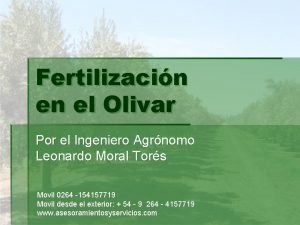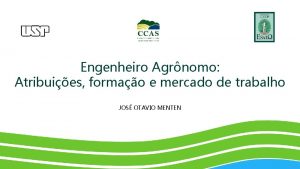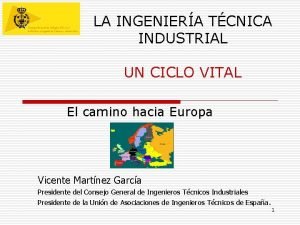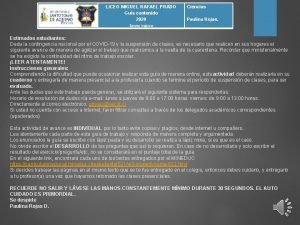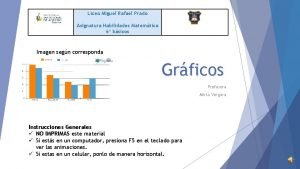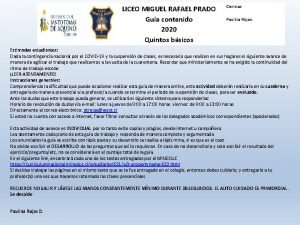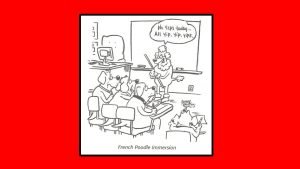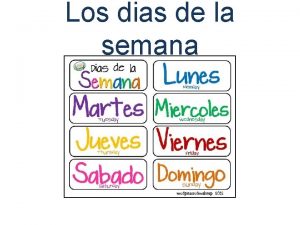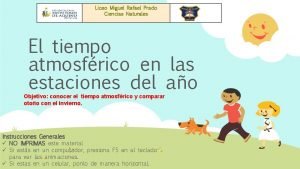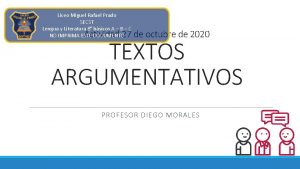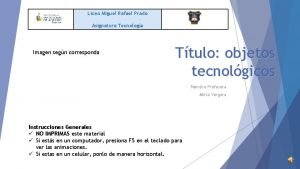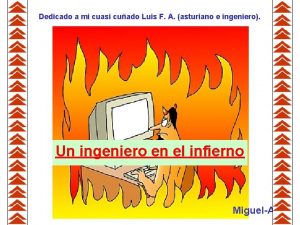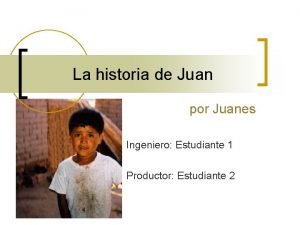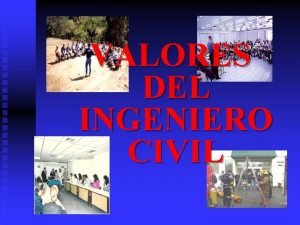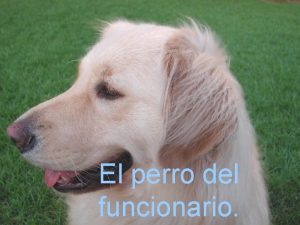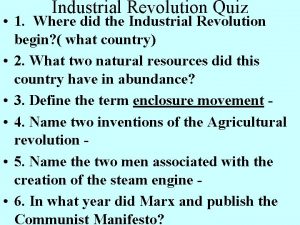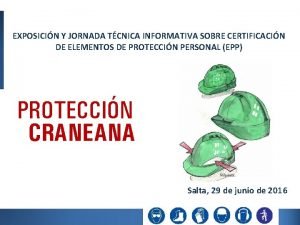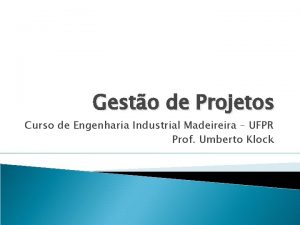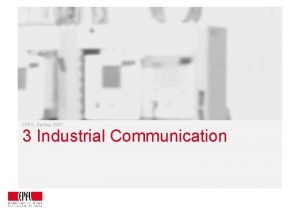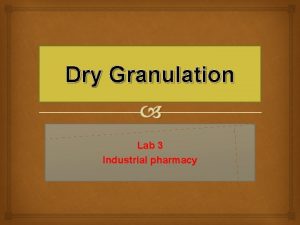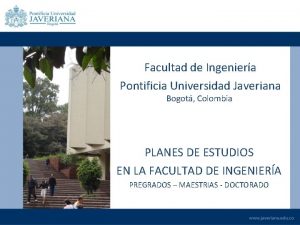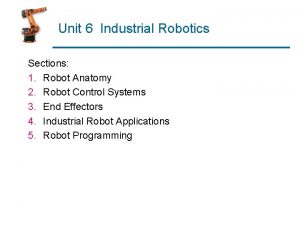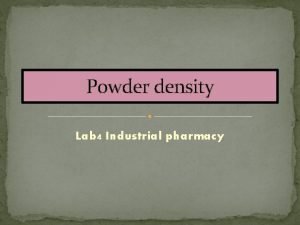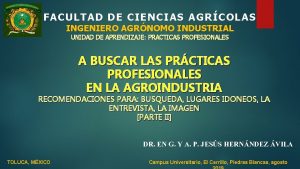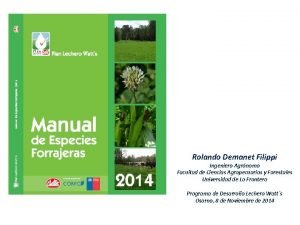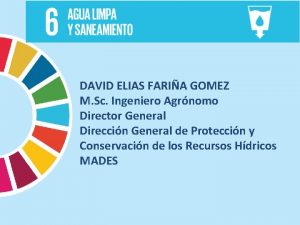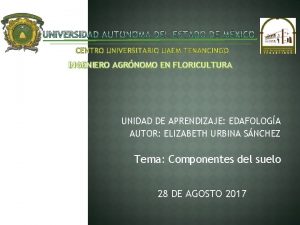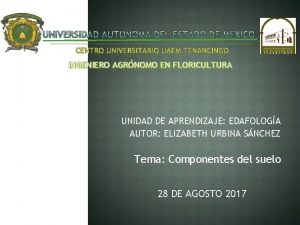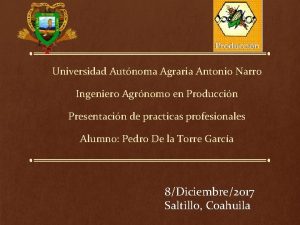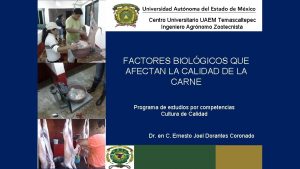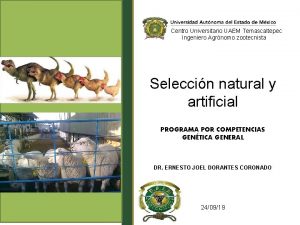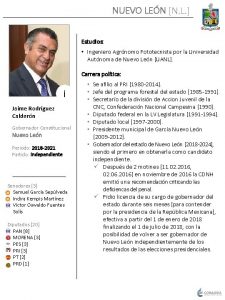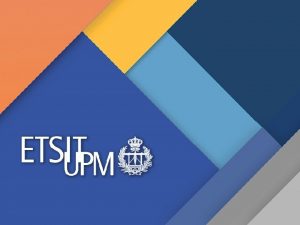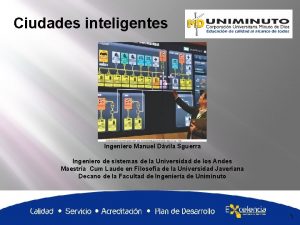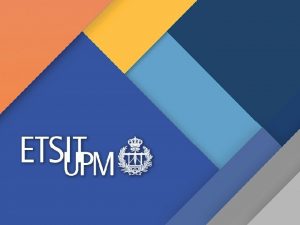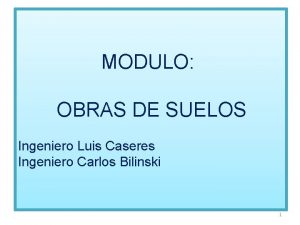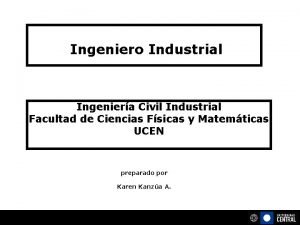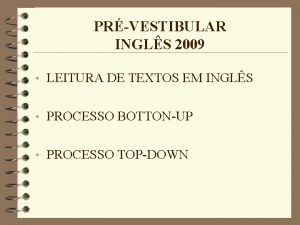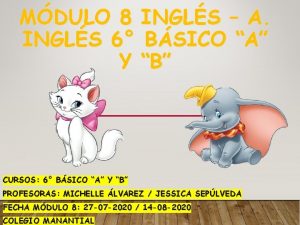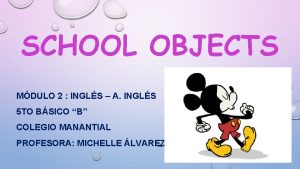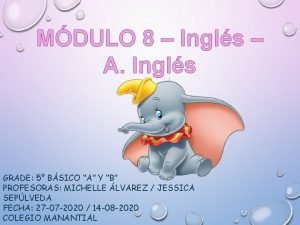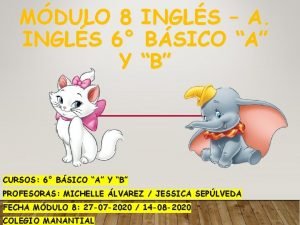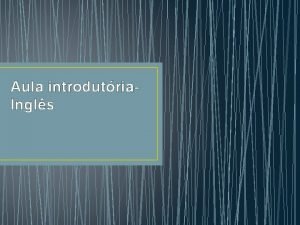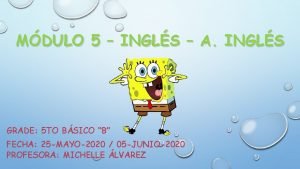Ingls 6 Ingeniero Agrnomo Industrial L L I
































- Slides: 32

Inglés 6 Ingeniero Agrónomo Industrial L. L. I Ricardo Alvarez Mercado Octubre 2016

Inglés 6 Ingeniero Agrónomo Industrial Objetivos del programa Educativo Implementar sistemas de acondicionamiento de la producción agrícola y pecuaria para su destino hacia las agroindustrias o su comercialización en fresco. Organizar procesos industriales de conservación y transformación de los productos agrícolas y pecuarios. Diseñar procesos agroindustriales innovadores para la conservación y transformación de los productos agrícolas y pecuarios. Contribuir en los procesos financieros y administrativos de las empresas agroindustriales. Proveer asistencia técnica a productores agropecuarios y a empresarios agroindustriales. Realizar investigación tendiente a la mejora e implementación de sistemas agroindustriales más productivos. Difundir la cultura agrícola y agroindustrial en diferentes niveles de la sociedad. Revisar la normatividad específica a los productos agrícolas y agroindustriales con el fin de mejorar la calidad de insumos y producto terminado.

Objetivos de la Unidad de Aprendizaje Reconocer y aplicar estructuras, vocabulario y estrategias comunicativas del idioma inglés para interactuar de manera semi guiada en forma oral y escrita en situaciones cotidianas al narrar hechos pasados, situaciones presentes y anhelos a futuro, dar información haciendo referencia a la fuente y describir procesos haciendo énfasis en el objeto que recibe la acción.

La unidad de aprendizaje Inglés 6 junto con el curso que le antecede, Inglés 5, están encaminados a llevar al estudiante a un nivel de desarrollo de la lengua que le permita lograr las competencias descritas por el Marco Común Europeo de Referencia para el Aprendizaje de Lenguas correspondientes al umbral del nivel de usuario independiente (B 1), por ello, el profesor que imparta esta unidad de aprendizaje debe apoyarse en esta guía mínima y en materiales adecuados e implementar métodos y estrategias de enseñanza que lleven a sus estudiantes a desarrollar la destreza comunicativa para comprender y producir discursos de manera oral y escrita al interactuar en situaciones comunes, a ser capaces de tomar la iniciativa al momento de enfrentar situaciones poco usuales en las que sea necesario pedir alguna aclaración o explicación para comprender con precisión, así como parafrasear y hacer uso de estrategias comunicativas cuando la idea a expresar y el contexto requieran mayor puntualidad.

Eventos presentes, pasados y futuros Objetivo: Reforzar conocimientos y habilidades receptivas y productivas desarrolladas previamente al compartir eventos pasados, hablar de situaciones presentes y expresar planes y anhelos a futuro.

Uses of Present Simple is normally and basically used for: • Facts: things that are true in general. Natural and/or Physical Laws. Example: Water boils at 100°C at sea level. Water consists of hydrogen and oxygen. The average person breathes 21, 600 times a day. The world is round. Routines: actions that happen every day or almost every day. Example: I listen to music every day before going to school. I get up at seven every morning. She always eats a salad for lunch.

Spelling rules Verbs only change when the subject is a third person (he, she, it). They add –s or -es. However, these spelling rules apply to the last ending –es.

PRESENT CONTINUOUS Uses of Present Continuous, also known as Present Progressive, is basically used for Activities that are in progress at the moment of speaking. It is temporary because it began in the past, continues at the present and will probably end at some point in the future. Example: The students are sitting at their desks right now. I need an umbrella because it is raining. I am taking five courses this semester.

Other uses of Present Continuous There are certain uses of the Present Continuous which require deeper knowledge of the English Language. As presented here: State verbs when we want to emphasise that a situation is temporary or for a period of time around the present such as: attract, like, look, love, sound. Example: Jane´s with us at the moment. The children are loving having here.

Mental states when we want to emphasise that we recently started to think about something or that we are not sure about something. These verbs are commonly regret and consider. Example: I´m regretting my decision to give her the job. (This sentence means that I am increasingly aware that it was the wrong decision) Performatives such as apologise, deny, guarantee, promise, suggest have a similar meaning with either the present simple or the present continuous in negative sentences. Example: I´m not denying taking the books, but Andy said it would be okay (It has the same meaning as I don´t deny taking the books, but Andy said it would be okay).

Action verbs such as anticipate, cost, expect, feel, fit, have, imagine, measure, weigh, appear, think can take simple or continuous forms with different meanings. Example: The new treatments for influenza doesn´t appear to work. (appear: state = seem) Madonna is currently appearing in a musical on Broadway (appear: action = take part). Do you think it´s a good idea? (think: state = about an opinion) I´m thinking of going in August. (think: action = consider)

Structure of Present Continuous

Spelling rules Spelling of –ing forms VERBS THAT END IN A CONSONANT AND -e VERBS THAT END IN A VOWEL AND A CONSONANT Hope hoping Date dating Injure injuring ONE-SYLLABLE VERBS Stop stopping Rob robbing Rain Fool VERBS THAT END TWO CONSONANTS VERBS THAT END IN -y IN -ING FORM: If the verb ends in –e, drop the –e and add –ing. * 1 vowel 2 consonants** 2 vowels 1 consonant raining fooling TWO-SYLLABLE VERBS Listen listening Offer offering 1 st syllable stressed consonant 1 Begin Prefer 2 nd syllable stressed consonants 2 beginning preferring Start starting Fold folding Demand demanding Enjoy Pray enjoying praying Study Try Reply studying trying replying If the word ends in two consonants, just add the ending. If –y is preceded by a vowel, keep the –y.

Present Simple vs. Present Continuous

We often use the present simple and present continuous in stories and jokes in informal spoken English to create the impression that events are happening now. This can make them more direct and exciting and hold people´s attention. Example: She goes up to this man and looks straight into his eyes. He´s not wearing his glasses, and he doesn´t recognize her… This man´s playing golf when a kangaroo bounds up to him, grabs his club and hits his ball about half a mile… The main events are usually described in sequence using the present simple and longer background events are described using the present continuous. In narratives and anecdotes the present simple can be used to highlight an event. Often it is used after past tenses and with a phrase such as suddenly or all of a sudden. Example: I was sitting in the park reading a newspaper, when all of a sudden this dog jumps at me.

We also use the present simple and present continuous in live commentaries (for example, on sports events) when the report takes palace at the same time as the action. Example: King serves to the left-hand court and Adams makes a wonderful return. She´s playing magnificent tennis in this match… We can use the present simple in phrases such as It says here, I hear, I gather, I see, I understand They say, (someone) says, (someone) tells me to introduce news that we have heard, read, seen (e. g. on television), or been told. We can also use past tenses (e. g. It said here, I heard). Example: I gather you´re worried about Ken. Professor Otto is at the conference and I hear she´s an excellent speaker. We can use the present (or past) continuous rather than the present (or past) simple with the verb wonder if we want to be especially friendly or polite, particularly if we are unsure about the other person´s feelings toward something or how they will react to what we say. Example: You said that there were only 50 books in the boxes. I´m just wondering/I was wondering whether you counted them all? (more polite than “I just wonder…? ”)

PAST CONTINUOUS VS SIMPLE PAST. . Past Continuous - Use The Past Progressive is used when we talk about something which was happening at a special time in the past. It is also called Past Continuous. Have a look at the following examples: 1) action was in progress at special time in the past Peter was reading a book yesterday evening. She was listening to the radio. 2) two actions were happening at the same time (the actions do not influence each other) Anne was writing a letter while Steve was reading the New York Times. 3) together with the Simple Past While we were sitting at the breakfast table, the telephone rang Note: Past Progressive: were sitting at the table Simple Past: the telephone rang. The action in the Simple Past interrupted the action in the Past Progressive. 4) repeated actions irritating the speaker (with always, constantly, forever) Andrew was always coming late. (I don't like it. )

STRUCTURE. AFFIRMATIVE NEGATIVE QUESTION I, HE, SHE, IT Was working last week. I, HE, SHE, IT Wasn´t working last week. Was I, HE, SHE, IT working last week? YOU, WE, THEY We’re working last week. YOU, WE, THEY Weren´t working last week. Were YOU, WE, THEY working last week?

Simple Past - Use The Simple Past is used to talk about actions or situations in the past. It is also called Past Simple. Have a look at the following examples: 1) action finished in the past (single or repeated) I visited Berlin last week. Andrew watched TV yesterday. 2) Series of completed actions in the past First I got up, then I had breakfast. 3) Together with the Past Progressive/Continuous - The Simple Past interrupted an action which was in progress in the past. They were playing cards when the telephone rang. 1 st action: Past Progressive were playing 2 nd action: Simple Past rang

STRUCTURE: AFFIRMATIVE REGULAR I YOU HE SHE IT walked all day. WE THEY IRREGULAR I YOU HE SHE IT said. WE THEY NEGATIVE QUESTION I YOU HE SHE IT didn´t walked all day. WE THEY I Did YOU HE SHE IT all day? WE THEY I YOU HE SHE IT WE THEY I Did YOU HE SHE IT WE THEY didn´t say. walk say? SHORT ANSWERS Yes, I, YOU, HE SHE IT, WE THEY Did. No, I, YOU, HE SHE IT, WE THEY Didn´t.

We add –ed to regular verbs to form the past simple. Example: work-worked, walked, play-played. Notice the spelling rules for other regular verbs. • For verbs ending in -e, we add –d: die- died. • For verbs ending in –y, we change the –y to I and add –ed: try-tried, cry-cried, studystudied. • For verbs ending in vowel + consonant (not -w, -x or –y), we double the consonant: stop- stopped. Some verbs have an irregular affirmative form in the past simple: Be- was/were, do-did, go-went, drive-drove, know-knew, take-took. We use the auxiliary verb did/didn´t to form negatives and questions. Example: Kirsten didn´t go on the adventure. Did you live in Peru? We also use did / didn´t to form short answers. Example: Did you live in Peru? Yes, I did. Did Kirsten go on the adventure? No, she didn´t.

SUMMARY. Completed Action in the Past Use the Simple Past to express the idea that an action started and finished at a specific time in the past. Sometimes, the speaker may not actually mention the specific time, but they do have one specific time in mind. Examples: I saw a movie yesterday. I didn't see a play yesterday. Last year, I traveled to Japan. Last year, I didn't travel to Korea. Did you have dinner last night? She washed her car. He didn't wash his car.

A Series of Completed Actions We use the Simple Past to list a series of completed actions in the past. These actions happen 1 st, 2 nd, 3 rd, 4 th, and so on. Examples: I finished work, walked to the beach, and found a nice place to swim. He arrived from the airport at 8: 00, checked into the hotel at 9: 00, and met the others at 10: 00. Did you add flour, pour in the milk, and then add the eggs?

Duration in Past The Simple Past can be used with a duration which starts and stops in the past. A duration is a longer action often indicated by expressions such as: for two years, for five minutes, all day, all year, etc. Examples: I lived in Brazil for two years. Shauna studied Japanese for five years. They sat at the beach all day. They did not stay at the party the entire time. We talked on the phone for thirty minutes. A: How long did you wait for them? B: We waited for one hour.

Habits in the Past The Simple Past can also be used to describe a habit which stopped in the past. It can have the same meaning as "used to. " To make it clear that we are talking about a habit, we often add expressions such as: always, often, usually, never, when I was a child, when I was younger, etc. Examples: I studied French when I was a child. He played the violin. He didn't play the piano. Did you play a musical instrument when you were a kid? She worked at the movie theater after school. They never went to school, they always skipped class.

Past Facts or Generalizations The Simple Past can also be used to describe past facts or generalizations which are no longer true. As in USE 4 above, this use of the Simple Past is quite similar to the expression "used to. " Examples: She was shy as a child, but now she is very outgoing. He didn't like tomatoes before. Did you live in Texas when you were a kid? People paid much more to make cell phone calls in the past. IMPORTANT When-Clauses Happen First Clauses are groups of words which have meaning but are often not complete sentences. Some clauses begin with the word "when" such as "when I dropped my pen. . . " or "when class began. . . " These clauses are called when-clauses, and they are very important. The examples below contain when-clauses. Examples: When I paid her one dollar, she answered my question. She answered my question when I paid her one dollar.

FUTURE FORMS: WILL Use 1) Future actions happen without the speaker's intention The sun will shine tomorrow. 2) Predictions, assumptions I think Sue will arrive in Paris at 6 pm. 3) Spontaneous actions Hang on! I'll have a word with you. Examples Affirmative sentences: He will play football. He'll play football. Negative sentences: He will not play football. He won't play football. or He'll not play football. Questions: Will he play football?

FUTURE FORMS GOING TO Use 1) planned actions in the future We are going to sing at the party. 2) You are certain that sth. is going to happen in the future. Look at that car! It is going to crash into the yellow one. Form to be (am, are, is) + going to + infinitive Examples Affirmative sentences: I am going to play handball. I'm going to play handball. You are going to play handball. You're going to play handball.

Negative sentences: I am not going to play handball. I'm not going to play handball. You are not going to play handball. You're not going to play handball. You aren't going to play handball. Questions: Am I going to play handball? Are you going to play handball? ATTENTION!! Do not mix up with the Present Progressive! going to-future Present Progressive He's going to read the book. He's reading the book. The going to-future is one future tense. There are other future tenses, like the willfuture, the Present Progressive, the Future Progressive/Continuous and the Simple Present.

FUTURE FORMS: PRESENT CONTINUOUS Use 1) Actions happening at the moment of speaking Peter is reading a book now. 2) Fixed plan in the near future She is going to Basel on Saturday. 3) Temporary actions His father is working in Rome this month. 4) Actions happening around the moment of speaking (longer actions) My friend is preparing for his exams. 5) Trends More and more people are using their computers to listen to music. 6) repeated actions which are irritating to the speaker (with always, constantly, forever) Andrew is always coming late.

Form To be (am, are, is) + infinitive + -ing Examples Affirmative sentences: I am playing football. I'm playing football. You are playing football. You're playing football. Negative sentences: I am not playing football. I'm not playing football. You are not playing football. You're not playing football. You aren't playing football. Questions: Am I playing football? Are you playing football?

BIBLIOGRAPHY. Bourke, Kenna (2003) English Verbs and Tenses English Grammar. UK: OUP. Diccionario Oxford Study (2000). China: OUP. Hewings, M. (2007) Advanced Grammar in Use. Italy: C. U. P Hughes. J. , et. al. Life Pre-Intermediate. National Geographic. Cengage Learning. Student´s Book. Hughes. J. , et. al. Life Pre-Intermediate. National Geographic. Cengage Learning Teacher´s Book. Murphy. R. , (2002) Basic Grammar in Use. C. U. P. Oxenden. C. , et. al. New English File Pre-intermediate. O. U. P. Johannsen Kristin (2010) World English Two. Boston, USA. Heinle CENGAGE Learning
 Agrnomo
Agrnomo Agrnomo
Agrnomo Objetivos de un ingeniero industrial
Objetivos de un ingeniero industrial Regulacion profesion ingeniero industrial
Regulacion profesion ingeniero industrial Habilidades de ingeniero industrial
Habilidades de ingeniero industrial 100 preguntas para la ciudadana 2020 en ingls
100 preguntas para la ciudadana 2020 en ingls Preguntas de ciudadana 2020 en ingls
Preguntas de ciudadana 2020 en ingls Ingls
Ingls Preguntas de ciudadana en ingls
Preguntas de ciudadana en ingls Language respuestas
Language respuestas Los días dela semana en inglés
Los días dela semana en inglés El tiempo
El tiempo Preguntas para la ciudadana en ingls
Preguntas para la ciudadana en ingls Preguntas para la ciudadana americana 2020 en ingls
Preguntas para la ciudadana americana 2020 en ingls Cuasi ingeniero
Cuasi ingeniero Juan de juanes biografia
Juan de juanes biografia Valores del ingeniero civil
Valores del ingeniero civil Perro ingeniero
Perro ingeniero Tvs industrial and logistics parks
Tvs industrial and logistics parks Quiz 1 early development of industry
Quiz 1 early development of industry Suportes de tubulação
Suportes de tubulação Norma iram 3620
Norma iram 3620 Boehm's top 10 principles
Boehm's top 10 principles Ndsu industrial engineering
Ndsu industrial engineering Engenharia industrial madeireira ufpr
Engenharia industrial madeireira ufpr 29 cfr 1910 osha 178
29 cfr 1910 osha 178 Industrial automation epfl
Industrial automation epfl Proyecto de produccion industrial
Proyecto de produccion industrial Anatomy of industrial disputes
Anatomy of industrial disputes Slugging in tablet manufacturing
Slugging in tablet manufacturing Pensum ingeniería industrial javeriana
Pensum ingeniería industrial javeriana Robot anatomy diagram
Robot anatomy diagram Bulk density in industrial pharmacy
Bulk density in industrial pharmacy
